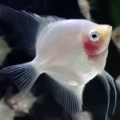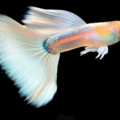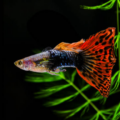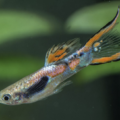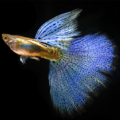What’s that shiny fish in your aquarium, and how can you keep its shimmering scales bright, healthy, and attractive? This complete guide on Platinum guppy care will show you how!

The Radiant Platinum Guppy
Welcome back, aqua-lovers. Today, we dive into the world of the dazzling Platinum Guppy also known as the White Guppy, which is a unique pigment-less variant of the guppy species.
This luxurious freshwater fish stands out among other shimmering guppy species for its unique iridescent scales that reflect light beautifully and create a stunning visual display. As a rare metallic fish, the platinum guppy adds an element of elegance to any tank setup and enhances the overall ambiance.
Whether you’re looking to start a new tank or enrich an existing one, the Platinum Guppy promises to bring sophistication and charm to your aquatic collection.
Origins and Breeding Development
The Platinum Guppy’s heritage comes from a deep, extensive culture of selective breeding aimed at enhancing the unique qualities of this stunning fish.
Initially derived from the wild guppy population, breeders recognized the potential for more striking appearances and began an isolated process of breeding for metallic sheen only.
By breeding fish with desirable traits, breeders refined the Platinum Guppy’s appearance, emphasizing its distinct shine and birthing this exotic guppy lineage we all love. Over generations, breeders have continued to practice more intentional breeding techniques to safeguard the development of platinum guppy traits in this fish.
Distinctive Physical Characteristics of Platinum Guppies

This fish has standout guppy features like its metallic look from its gleaming silver scales that shimmer in various lighting conditions. This unique, radiant fish coloration enhances their overall beauty, but that’s not the only distinctive physical characteristic of the Platinum Guppy fish.
Another unique aesthetic of this fish is the display of its lustrous fan-shaped tail that gracefully glides as it makes its way through the water, highlighting its beauty.
That metallic fish elegance we love this fish for is also displayed by the fish’s slender, elongated body, large dark eyes, and prominent gill plates. You can preserve this metallic fish’s elegance by being attentive and giving it the best care possible.
If you’re ready to add these gleaming silver guppies to your tank, here are some guidelines to help you achieve a thriving aquarium.
Essential Care Guidelines
Interested in having these beauties in your tank? Pay attention to these tips on providing premium care for Platinum Guppies.
Water conditions
Maintain temperature between 72°F and 82°F with a pH level of 6.5 to 7.5, which is slightly alkaline like its Brackish natural habitat. Testing the tank water regularly ensures you provide the required water care for shimmering fish like the Platinum Guppy.
Tank
Your tank should be at least 10 gallons for a small group of Platinum Guppies because it gives them enough space to swim and thrive. Ensure the tank is well-filtered to maintain clean water and perform weekly partial water changes of 15-20% to reduce toxins. You can use a sponge or hang on a back filter to achieve this.
By creating optimal conditions for metallic fish, you can ensure that your Platinum Guppies live a healthy, stress-free life, displaying their stunning beauty and lively behaviors. But there are some more things you need to do beyond perfecting the water parameters. ,. Pay attention to the guppy maintenance essentials in this article to keep your guppies healthy and vibrant, and then follow these design tips to create the ideal tank.
Creating the Ideal Tank Environment
Tank Size
A well-planned tank setup for gleaming guppies should be spacious, with a minimum of 10 gallons to allow for wide swimming and social interaction.
Lighting
Good lighting for metallic fish, like LED lights that outline their shimmering scales, should be used. Soft, bright lighting can bring out the full brilliance of their colors, creating a visually stunning effect.
Decoration and Substrates
Decors such as smooth rocks, driftwood, and gentle substrate can help with enhancing the aquarium’s aesthetics, giving it some life.
Use complementary plants for fish tanks, such as Java fern and Anubias, to add greenery that contrasts beautifully with their silver glistening scales.
Wondering what these shiny fish eat and how they keep their scales glistening?

Feeding and Nutrition for Platinum Guppies
This feeding and nutrition guide provides tips on adequately providing nutrition for metallic guppies for their healthy growth and physical appearance.
An adequate diet for Platinum Guppy Vibrance includes high-quality protein from daphnia and brine shrimps. Fish oil supplements and vitamins A and C-rich foods(leafy greens and fruits) are necessary for feeding for gleaming scales.
To enhance guppy coloration with diet, provide guppy with carotenoid-rich foods (paprika, astaxanthin), maintain optimal water parameters, and regularly mix up feeding components.
You don’t need to feed this fish in large quantities or multiple times. Feed 2-3 times daily in quantities they can consume within 1-2 minutes.
Feeding a balanced diet will have your Platinum Guppies displaying gleaming scales, vibrant coloration, and optimal health.
For more on feeding your aquatic pets check out The Ultimate Guide to Fish Food: Pros and Cons & Best Choices!
Common Health Issues and Prevention Strategies
Maintaining healthy Platinum Guppies requires attention to specific health issues that can affect their unique coloration and overall well-being.
Epistylis
These are small, white, thread-like parasites on the scale of the fish.
- Prevention: Maintain optimal water parameters, Provide nutrient-rich balanced diets, and perform
- Early Detection: Monitor for small, white, thread-like parasites on the scales and Look out for labored breathing, lethargy, or loss of appetite
- Treatment: Quarantine affected fish, Administer antiparasitic medications, and Improve water quality
Fish Lice
These are external parasites causing irritation and scratching in the fish.
- Prevention: Inspect new fish before introducing them to the tank, Maintain optimal water parameters, and Provide plenty of hiding places
- Early Detection: Monitor for external parasites attached to the scale and observe fish for excessive scratching or swimming irregularities.
- Treatment: Quarantine affected fish and administer antiparasitic medications.
Gill Disease
This is a bacterial infection affecting the gills of the fish.
- Prevention: Maintain optimal water parameters and provide a nutrient-rich, balanced diet.
- Early Detection: Monitor for labored breathing, lethargy, or rapid breathing and Inspect gills for signs of infection.
- Treatment: Quarantine affected fish and treat them with antibiotic medications.
Remember, early detection and prompt treatment are crucial for effective disease management. Regular monitoring and maintenance can help prevent disease.
Breeding Platinum Guppies: Key Considerations
Breeding this fish involves careful selection because it’s a species born from genetic modification. Pay attention to the several environmental factors that I will list below to achieve excellent breeding for metallic sheen traits across generations.
Selecting Breeding Pairs
When selecting breeding pairs, pay attention to the health and vibrant look of the possible candidates. Look for individuals with strong coloration, good body shape, and active behavior. It’s important to select pairs that exhibit these features if maintaining Platinum traits in the fish is important to you.
This video has been very helpful in identifying the sex of Guppies, I highly recommend it:
Ideal Conditions
Use a breeding tank with stable water parameters of pH around 7.0 and a temperature between 75-82°F, and provide plenty of hiding spots and plants. Use a separate breeding tank to minimize stress and protect the fry from adult fish, or divide your tank to create a breeding area if it’s larger than 30 gallons.
Breeding process
Introduce the selected pairs and monitor them closely. After mating, the female births fry in about 28 days. Feeding high-quality, nutrient-rich foods that enhance their growth and coloration are some of the actions you can take towards preserving guppy brilliance in fry.
Fry Aftercare
Continuously evaluate the offspring for desirable traits and selectively breed those with the best characteristics. Assess and refine your breeding strategy for optimal results.
Platinum Guppies are social fish that thrive in groups, exhibiting interesting social dynamics in their behavior, which enhances their vibrancy and makes them an absolute joy to watch in the aquarium.
If you’re considering pairing Platinum Guppies with other fish, make sure you pair with peaceful tank mates. Consider small, non-aggressive species like neon tetras, rasboras, or mollies, which complement the guppies’ lively nature.
Ensure all tank mates share similar water requirements and dietary needs.
Monitor tank conditions closely and provide ample hiding spots to minimize territorial disputes. Regularly check for compatibility and avoid larger, more aggressive fish that might intimidate or harm the guppies.
Carefully selecting companions ensures you create harmony in your community tanks, which allows you to showcase the beauty of the fish.
Conclusion
Platinum Guppies are a striking metallic fish for tanks and make a wonderful addition to any aquarium due to their stunning beauty and elegant appearance.
In addition to their aesthetic appeal, they require effortless care, adapting well to various water conditions and dietary needs. Their friendly nature makes them enjoyable to observe, as they thrive in groups and exhibit lively behaviors.
Overall, you can elevate your aquarium with Platinum Guppies to get a captivating and enriching aquarium experience whether you’re a novice or an experienced aquarist.

